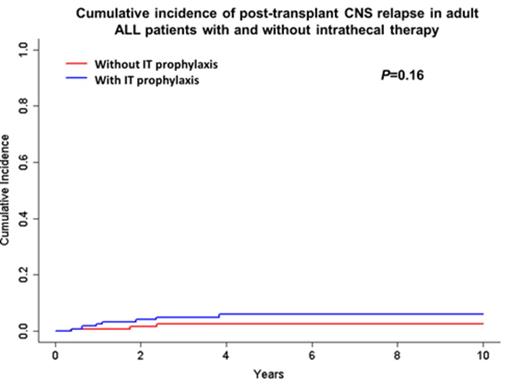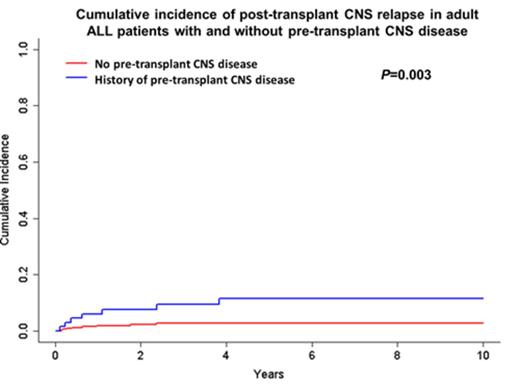Abstract

Central nervous system (CNS) recurrence after allogeneic hematopoietic stem cell transplantation (HSCT) confers a poor prognosis in adult patients with acute lymphoblastic leukemia (ALL). Preventing CNS recurrence after HSCT remains a therapeutic challenge, and criteria for post-HSCT CNS prophylaxis have not been addressed. Our goal was to investigate the post-HSCT outcome of ALL patients and identify patient groups who may benefit from post-HSCT CNS prophylaxis.
In this two-center retrospective study, we studied all adult (age≥18) ALL patients who underwent HSCT at MD Anderson Cancer Center or Fred Hutchinson Cancer Research Center between 1997 and 2011. We included all adult ALL patients who were transplanted in the first or second complete remission (CR) and who received any prophylactic or therapeutic CNS therapy before HSCT. We assessed the cumulative incidence of systemic and CNS relapses in a competing risks framework with a competing risk of non-relapse death. Since data from second and subsequent relapses were not available, patients whose first relapse did not include CNS involvement were censored at the time of relapse. To analyze the association between post-HSCT CNS prophylactic therapy and CNS relapse, we used a landmark analysis, including only patients who had not relapsed or died by 3 months post HSCT.
We included 415 adult ALL patients (239 in CR1 and 176 in CR2) who were transplanted with a myeloablative total body irradiation based (MA-TBI, n=252), myeloablative non-TBI based (MA-nonTBI, n= 130), or reduced intensity conditioning regimen (RIC, n=33). Median age at HSCT was 37 years (range 18-70; 59% male). Sixty seven patients (16%) had a history of pre-HSCT CNS involvement either at diagnosis or at time of first relapse, while 339 patients (81%) had no CNS disease at any time before HSCT. Overall 175 patients (42%) received CNS prophylaxis after HSCT. CNS prophylaxis included intrathecal methotrexate, cytarabine, or both agents. Two patients received prophylactic cerebrospinal radiotherapy.
The median follow-up for the 189 surviving patients was 4.2 years. Sixteen patients (3.8% of all patients, 13.2% of all relapses) developed CNS relapse (11 isolated and 5 combined with marrow relapse) at a median of 231 days (range 38-1397) after HSCT. Seven of these patients had pre-HSCT CNS disease. The 4-year cumulative incidence of relapse after HSCT among all patients was 31.7% and 28.2% for patients with and without CNS prophylaxis after HSCT, respectively (P=0.51). The 4-year cumulative incidence of CNS relapse was 6% and 2.6% for patients with and without CNS prophylaxis after HSCT, respectively (P=0.16) (Figure 1). When the analysis was limited to the patients without prior CNS involvement, there was still no benefit to post-HSCT CNS prophylaxis (P=0.63). Patients with a prior history of CNS involvement with leukemia had a significantly higher rate for CNS relapse, 11.6% vs. 2.7% (P=0.003) (Figure 2). The 4-year rate of CNS relapse was not impacted by intensity of the HSCT conditioning regimen and was 3%, 4%, and 6.5% for RIC, MA-TBI, and MA-nonTBI, respectively.
CNS relapse is an uncommon event following HSCT for ALL in CR1 or CR2. Furthermore, neither the intensity of the HSCT conditioning regimen nor the routine use of post-HSCT CNS prophylaxis made a significant difference in the rate of post-HSCT CNS relapse in patients who had received CNS prophylaxis prior to HSCT. Not surprisingly, patients with a pre-HSCT history of CNS involvement had a significantly higher risk of CNS relapse after HSCT.
No relevant conflicts of interest to declare.
Author notes
Asterisk with author names denotes non-ASH members.

This icon denotes a clinically relevant abstract



This feature is available to Subscribers Only
Sign In or Create an Account Close Modal